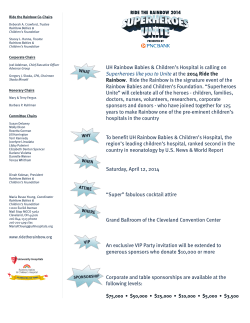
Optical Phenomenal Chapter 14 section 3
Optical Phenomenal Chapter 14 section 3 Objectives Predict whether light will be refracted or undergo total internal reflection. Recognize atmospheric conditions that cause refraction. Explain dispersion and phenomena such as rainbows in terms of the relationship between the index of refraction and the wavelength. Total Internal Reflection Total internal reflection can occur when light moves along a path from a medium with a higher index of refraction to one with a lower index of refraction. At the critical angle, refracted light makes an angle of 90º with the normal. Above the critical angle, total internal reflection occurs and light is completely reflected within Critical Angle Snell’s angle. law can be used to find the critical nr sinC ni sine critical angle for ni nr index of refraction of second medium index of refraction of first medium •Total internal reflection occurs only if the index of refraction of the first medium is greater than the index of refraction of the second medium. Example Find the critical angle for a water-air boundary if the index of refraction of water is 1.333 Atmospheric Refraction Refracted light can create a mirage. What is a mirage? A mirage is an optical effect of the atmosphere caused by refraction when light passes from air with one density into air with a different density and the object appears displaced from its true position. The mirage called an inferior mirage occurs when the image appears below the true location of the observed object. During a phenomenon called looming, objects sometimes appear to be suspended above the horizon. Looming is considered a superior mirage because the image is seen above its true position. A mirage that changes the apparent size of an object is called towering. A type of towering, called Fata Morgana, is frequently observed in coastal areas as towering castles that appear out of thin air. Mirages A mirage is produced by the bending of light rays in the atmosphere where there are large temperature differences between the ground and the air. Mirages Dispersion Dispersion is the process of separating polychromatic light into its component wavelengths. White light passed through a prism produces a visible spectrum through dispersion. Rainbows Perhaps the most spectacular and best known atmospheric optical phenomenon is the rainbow. Sunlight and water droplets are necessary for the formation of a rainbow. Furthermore, the observer must be between the Sun and rain. When a rainbow forms, the water droplets act as prisms and refraction disperses the sunlight into the spectrum of colors, a process called dispersion. The curved shape of the rainbow results because the rainbow rays always travel toward the observer at an angle between 40 and 42° from the path of the sunlight. Rainbows Lens Aberration Chromatic aberration is the focusing of different colors of light at different distances behind a lens. Chromatic aberration occurs because the index of refraction varies for different wavelengths of light. Lens aberration Video Watch a video Go over lab Lets go over lab Homework Do problems 1-4 pg .502 Closure Today we learned about optical phenomena Next class we are going to have a lab
© Copyright 2025



















